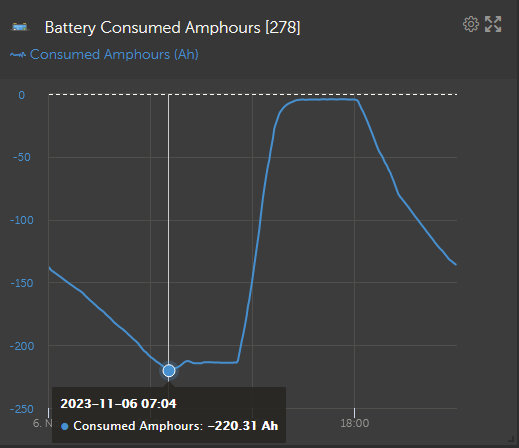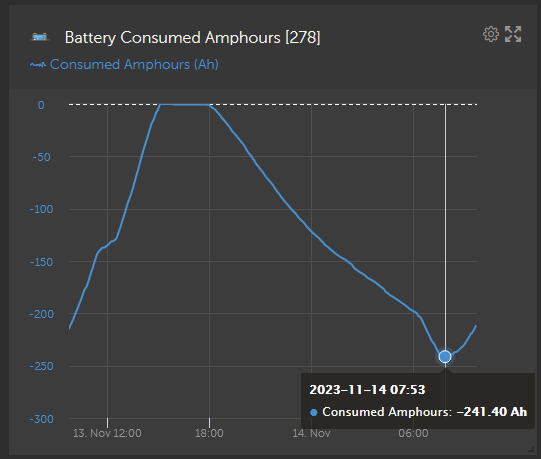I have a few of these around. Here is another one:
This is in D-flat major, with a bit in the middle in E, just to confuse you even more. Not that you wanted to know, but that’s the pain I subject myself to.
I have a few of these around. Here is another one:
This is in D-flat major, with a bit in the middle in E, just to confuse you even more. Not that you wanted to know, but that’s the pain I subject myself to.
Worse than being Rick-rolled.
Perfection.
However, this is also the time when things go “wrong”, as I learnt.
See, there is still some 10w-134w going into the batt, wattages that the BMS cannot pick up, hence 0W on the BMS. BMV sees that.
Then next moment a 100w draw … charge-discharge/charge-discharge with small wattages … balancer working nicely on volts > 3.45v
So yeah, this is the time when there is a problem cell, the volts will hit 3.65v on that cell/cells if the balancer cannot throttle that. Most BMS’es having mA balancers.
It will now do this charge-discharge/charge-discharge until it settles to 3.375v, still 100% SOC, the float volts.
At that point, the Delta is like ± 0.005v.
Me, I’m happy. Thank you. ![]()
… but I want to “push the envelope”. Ek ken nou wat die selle hier doen. Time for the next “test”.
A perfect example of how it now gets the batts to float voltage …
Batts are set to Keep Charged.
Man, touch screens, they look clean … geez!
Well, you know the charging curve. There is a steep hill at the charged end and a sea cliff at the discharged end.
A too-high and a too-low cell voltage can result in permanent damage.
At both ends, there will be negligible gains in usable capacity.
The thing is, though, the charged end is relatively well understood, and you probably have a balancing that will save your butt to a certain extent if you push things.
Credit goes to Andy down under for his charging experiments.
I haven’t seen Andy probe the discharge boundary.
The discharge limit has no such balancing, so a voltage rundown will happen quickly, and possibly catch you by surprise.
It is likely a riskier proposition to explore with no real upside.
I have.
Reminds me, he built that Frankenstein bank. Told him on YouTube chat that I already built one before he did, sommer 100ah 2nd Life cells with 280ah brand new cells, and that it can work if you keep well within the weakest cell/s range.
And yes, as you say …
Hence the 3v (to play, test, discover) and 3.45v - which is cast in stone.
And as I said, the inverter will cut off at 2.9v if I miss the moment.
Hence I’m pretty safe I reckon.
The more I think about it, as you say, “charged end is relatively well understood”, but few, not even Andy (yet) have explored the <20% SOC.
Will see where this leads … me thinking that changing the 280ah to 289ah will affect the calcs for a week or more, then to get the BMV back in sync with the BMS, then only running it to < 10% SOC and check what is potting “down under” over time. Must think it through carefully.
EDIT: Thinking some more about it.
The manufacturer says:
Min 2.6v.
Max 3.65v.
280ah.
6000 cycles.
Yet we run at 3.2v min, 3.45v max, and have 290ah cells.
What is the right sweet spot … my question, to not have the cells die of old age, having run them with loads of untapped potential energy all those years.
My Mother would say:
“If you fall off that wall and break your legs, don’t come running to me”.
Look Ma, no hands!!!
Right, I checked the AH again vs SOC that was set to 20% yesterday.
The system got down to 20.5% SOC before the sun started taking over.
Now 20% of 280ah = 56 so 280 - 56 = 224ah.
I used 220.31ah

So the 20% SOC setting and the ah drawn are pretty close according to the BMV.
The BMS SOC would be like ±26% based on observations in the past.
So if I had no BMV, I would have run the volts lower.
(deksels, their the volts from Eskom >250v - DB is disconnected from the street)
In any case, the figures I work on are BMV figures, not BMS. When I ran to Zero SOC on the BMV, BMS was still like at +10-15% SOC before I chickened out.
So the thing I want to determine … differently put … what is a) the bare minimum I can “safely” go in case of “drama” and b) how close can I get to the actual 280ah capacity, the BMV giving similar results as the BMS ito ah.
And then we have the fact that I have 290ah cells, at least, 289ah cells taking the lowest 3 in consideration. So let me keep that at 280ah for now. Another safety margin, the 2.9v inverter min and 3.45v the max top volts for the other two.
Cause seeing that 3.45 is a teeny weeny bit high still, that 3v is fine too. The red block where I want to see the BMS/BMV being kinda in sync better,
Just thought I share my thinking in more detail.
Some more thoughts …
A long time ago Andy did this test - also why I use 3.45v max.
Looking again at this graph:
My BMS “believes” 16% this morning. BMV sits at 14%. Not bad!
Here is the thing … the cells are at 3.21v.
Hence I wonder, on a DIY bank, how accurate are we really in the SOC calculations without copious amounts of measuring using the right tools?
Brand name 10-year warranty banks, they are tested to deliver exactly that on a large average.
DIY … we don’t know really bar what the manufacturer said the cells tested at in their factory.
The BMV AH?
241.40Ah for 16% at 3.21v … interesting.

True, but I just wondered, living on the fringes is fun “they” said.
Have this crazy idea of getting a big metal watertight container and put the batts inside that.
But why!?
IF there ever is a fire issue or a short and the bank starts “running away” from me downhill, my pudgy legs not keeping up, I stroll outside, grab the hosepipe, and fill said container with water, submerging the cells completely. Problem sorted.
Cause looking at fire extinguishers late one night, fire blankets, the thing with lithium is that one must get to the actual cells, each cell, to sort the issue, not the external casing,
The idea came from that Tesla that fire dept dug a hole and pushed the burning car into it. The problem was also sorted.
Water stops a lithium fire by cooling - so the mass of water must be MUCH larger than the cells. Too little water and you just generate lots of steam - which reacts VERY violently with lithium…
Bugger.
The idea was to have a deep container, with lots of water, cells must be properly submerged.
Will ponder some more on it, as the time to fill the container will take too long … so “reacts VERY violently with lithium” is not something I want to “try at home”.
Maybe I must open the pool again, the batt is on wheels, and if there ever is a fire, snip the cables and push it outside into the pool whilst wearing a gas mask.
![]()
Here is what I could figure out using my google-fu from all over.
If you have a battery that makes its own oxygen, as LCO, NMC etc does, then you cannot smother the fire. If you have a battery that doesn’t do that, you can smother the fire by taking away the oxygen.
LiFePO4 Does have oxygen in the chemistry (that little O4). Apparently it is bound quite tightly in the iron phosphate molecule, and you need a lot of heat to get it out.
Therefore cutting off the oxygen supply and at least moderately cooling it should keep it in check.
The danger is thermal runaway, where a small amount of heat makes more heat which makes more heat in a loop until you have an inferno. It seems like you need rather a lot of heat to start with to make that happen.
The bigger issue with LiFePO4 is that they off-gas hydrogen, which is explosive, and sulfur, which is poisonous. So good ventilation is probably more important.
Very glad I went to the extra expense to install in a garage (separate from house by a meter or so)… cost me 50m of thick cable but - peace if mind! Priceless…
For Lasers you can use these fire balls as a safety extinguisher. The sooner you can stop the flames the easier it is.
Not so sure how that will work with lithium batteries that can make their own oxygen. Perhaps a quick cut guillotine to cut the cables and then roll it out of the building to burn itself out?
As of today, Lifepo4 is the safest tech to use. Lead acid can also explode, seen pics of one UPS steel cabinet and 2 x 105ah batteries in pieces all over an office. No one was in the office when it exploded.
But both the above are not common … but it does happen.
Bad installs, no maintenance, the causes.
What can go wrong, do I have a plan for it … the reason for my musing on containers and water and all that.
Fire Balls, an excellent idea, but I do not think it is for lithium/Lifepo4, it being a “runaway” situation.
One needs to deal with lithium differently, hence the “drop it in water” conclusion (Tesla solution) I concluded.
One do get lithium fire extinguishers, posted that before, costly and I’m not sure if it will solve the issue, the “runaway” thing.
To keep the batts outside the house, garage, there are other issues to ponder on, like geckos, ants, spiders, temp.
I’m happy with them inside. Also have gas bottles inside. They are also a challenge, lots of chemicals under the zync, paint … issue issues.
In the meantime, I have temp 2 x Victron sensors on the bank, the bank is now always cool since I put an extractor fan (on a timer) that I removed out of a bathroom, temporarily on top of the battery box in a " Boer maak 'n plan" move … will make it “official” one of these weeks.
Fan on the right (on a timer) is for the MPPT’s and inverter, blowing them cool from below. The heat recently, I thought bugger this nonsense, if I’m this hot and bothered, my fav equipment shall be kept cool.
See, nice and cool, them cells: